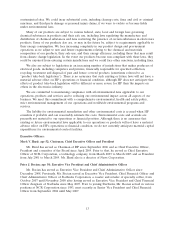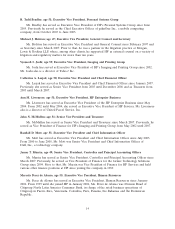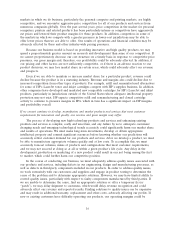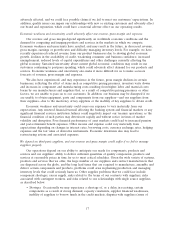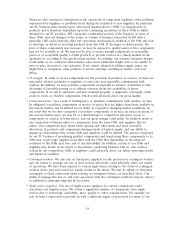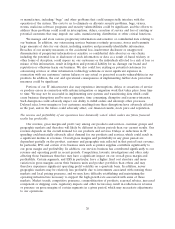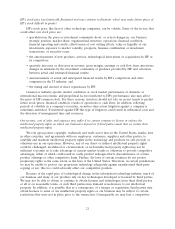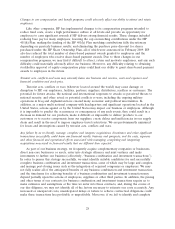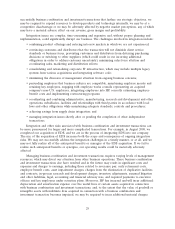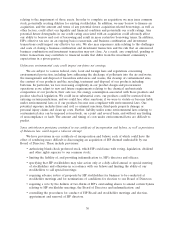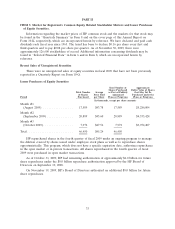HP 2009 Annual Report Download - page 30
Download and view the complete annual report
Please find page 30 of the 2009 HP annual report below. You can navigate through the pages in the report by either clicking on the pages listed below, or by using the keyword search tool below to find specific information within the annual report.• import, export or other business licensing requirements or requirements relating to making
foreign direct investments, which could increase our cost of doing business in certain
jurisdictions, prevent us from shipping products to particular countries or markets, affect our
ability to obtain favorable terms for components, increase our operating costs or lead to
penalties or restrictions;
• difficulties associated with repatriating cash generated or held abroad in a tax-efficient manner
and changes in tax laws; and
• fluctuations in freight costs, limitations on shipping and receiving capacity, and other disruptions
in the transportation and shipping infrastructure at important geographic points of exit and entry
for our products and shipments.
The factors described above also could disrupt our product and component manufacturing and key
suppliers located outside of the United States. For example, we rely on manufacturers in Taiwan for the
production of notebook computers and other suppliers in Asia for product assembly and manufacture.
As approximately 64% of our sales are from countries outside of the United States, other
currencies, particularly the euro, the British pound, Chinese Yuan Renminbi and the Japanese yen, can
have an impact on HP’s results (expressed in U.S. dollars). Currency variations also contribute to
variations in sales of products and services in impacted jurisdictions. Accordingly, fluctuations in foreign
currency rates, most notably the strengthening of the dollar against the euro, could have a material
impact on our revenue growth in future periods. In addition, currency variations can adversely affect
margins on sales of our products in countries outside of the United States and margins on sales of
products that include components obtained from suppliers located outside of the United States. We use
a combination of forward contracts and options designated as cash flow hedges to protect against
foreign currency exchange rate risks. The effectiveness of our hedges depends on our ability to
accurately forecast future cash flows, which is particularly difficult during periods of uncertain demand
for our products and services and highly volatile exchange rates. As a result, we could incur significant
losses from our hedging activities if our forecasts are incorrect. In addition, our hedging activities may
be ineffective or may not offset any or more than a portion of the adverse financial impact resulting
from currency variations. Gains or losses associated with hedging activities also may impact our revenue
and to a lesser extent our cost of sales and financial condition.
In many foreign countries, particularly in those with developing economies, it is common to engage
in business practices that are prohibited by laws and regulations applicable to us, such as the Foreign
Corrupt Practices Act. Although we implement policies and procedures designed to facilitate
compliance with these laws, our employees, contractors and agents, as well as those companies to which
we outsource certain of our business operations, may take actions in violation of our policies. Any such
violation, even if prohibited by our policies, could have a material adverse effect on our business and
reputation.
If we fail to manage the distribution of our products and services properly, our revenue, gross margin and
profitability could suffer.
We use a variety of different distribution methods to sell our products and services, including
third-party resellers and distributors and both direct and indirect sales to both enterprise accounts and
consumers. Successfully managing the interaction of our direct and indirect channel efforts to reach
various potential customer segments for our products and services is a complex process. Moreover,
since each distribution method has distinct risks and gross margins, our failure to implement the most
advantageous balance in the delivery model for our products and services could adversely affect our
revenue and gross margins and therefore our profitability. Other distribution risks are described below.
23


